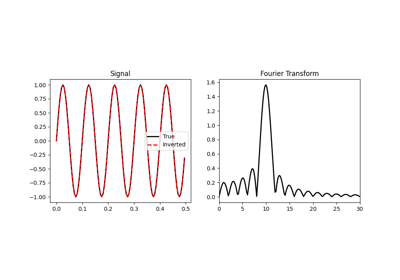pylops.signalprocessing.FFTND¶
-
class
pylops.signalprocessing.FFTND(dims, dirs=(0, 1, 2), nffts=(None, None, None), sampling=(1.0, 1.0, 1.0), dtype='complex128')[source]¶ N-dimensional Fast-Fourier Transform.
Apply n-dimensional Fast-Fourier Transform (FFT) to any n axes of a multi-dimensional array depending on the choice of
dirs. Note that the FFTND operator is a simple overload to the numpynumpy.fft.fftnin forward mode and to the numpynumpy.fft.ifftnin adjoint mode, however scaling is taken into account differently to guarantee that the operator is passing the dot-test.Parameters: - dims :
tuple Number of samples for each dimension
- dirs :
tuple, optional Directions along which FFTND is applied
- nffts :
tuple, optional Number of samples in Fourier Transform for each direction (same as input if
nffts=(None, None, None, ..., None))- sampling :
tuple, optional Sampling steps in each direction
- dtype :
str, optional Type of elements in input array
Raises: - ValueError
If
dims,dirs,nffts, orsamplinghave less than three elements and if the dimension ofdirs,nffts, andsamplingis not the same
Notes
The FFTND operator applies the n-dimensional forward Fourier transform to a multi-dimensional array. Without loss of generality we consider here a three-dimensional signal \(d(z, y, x)\). The FFTND in forward mode is:
\[D(k_z, k_y, k_x) = \mathscr{F} (d) = \int \int d(z,y,x) e^{-j2\pi k_zz} e^{-j2\pi k_yy} e^{-j2\pi k_xx} dz dy dx\]Similarly, the three-dimensional inverse Fourier transform is applied to the Fourier spectrum \(D(k_z, k_y, k_x)\) in adjoint mode:
\[d(z, y, x) = \mathscr{F}^{-1} (D) = \int \int D(k_z, k_y, k_x) e^{j2\pi k_zz} e^{j2\pi k_yy} e^{j2\pi k_xx} dk_z dk_y dk_x\]Both operators are effectively discretized and solved by a fast iterative algorithm known as Fast Fourier Transform.
Attributes: Methods
__init__(self, dims[, dirs, nffts, …])Initialize this LinearOperator. adjoint(self)Hermitian adjoint. apply_columns(self, cols)Apply subset of columns of operator cond(self, \*\*kwargs_eig)Condition number of linear operator. conj(self)Complex conjugate operator div(self, y[, niter])Solve the linear problem \(\mathbf{y}=\mathbf{A}\mathbf{x}\). dot(self, x)Matrix-matrix or matrix-vector multiplication. eigs(self[, neigs, symmetric, niter])Most significant eigenvalues of linear operator. matmat(self, X)Matrix-matrix multiplication. matvec(self, x)Matrix-vector multiplication. rmatmat(self, X)Adjoint matrix-matrix multiplication. rmatvec(self, x)Adjoint matrix-vector multiplication. todense(self)Return dense matrix. transpose(self)Transpose this linear operator. - dims :
